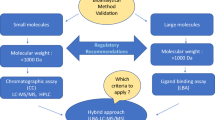Abstract
The Third American Association of Pharmaceutical Scientists/US Food and Drug Administration (FDA) Bioanalytical Workshop, which was held May 1 and 2, 2006, in Arlington, VA, addressed bioanalytical assays that are being used for the quantification of therapeutic candidates in support of pharmacokinetic evaluations. One of the main goals of this workshop was to discuss best practices used in bioanalysis regardless of the size of the therapeutic candidates. Since the last bioanalytical workshop, technological advancements in the field and in the statistical understanding of the validation issues have generated a variety of interpretations to clarify and understand the practicality of using the current FDA guidance for assaying macromolecular therapeutics. This article addresses some of the key elements that are essential to the validation of macromolecular therapeutics using ligand binding assays. Because of the nature of ligand binding assays, attempts have been made within the scientific community to use statistical approaches to interpret the acceptance criteria that are aligned with the prestudy validation and in-study validation (sample analysis) processes. We discuss, among other topics, using the total error criterion or confidence interval approaches for acceptance of assays and using anchor calibrators to fit the nonlinear regression models.
Similar content being viewed by others
References
Findlay JWA, Smith WC, Lee JW, et al. Validation of immunoassays for bioanalysis: a pharmaceutical industry perspective.J Pharm Biomed Anal. 2000;21:1249–1273.
DeSilva B, Smith W, Weiner R, et al. Recommendations for the bioanalytical method validation of ligand-binding assays to support pharmacokinetic assessments of macromolecules.Pharm Res. 2003;20:1885–1900.
Crowther JR.The ELISA Guidebook. Methods in Molecular Biology. Totowa, NJ: Humana Press; 2001.
Chard T. An introduction to radioimmunoassay and related techniques. In: Burdon RH, van Knippenberg PH, eds.Laboratory Techniques in Biochemistry and Molecular Biology. vol. 6. 3rd ed. New York, NY: Elsevier Press; 1987; Part 2, 175–193.
Rodbard D, Frazier GR. Statistical analysis of radioligand assay data.Methods Enzymol. 1975;37:3–22.
Dudley RA, Edwards P, Ekins RP, et al. Guidelines for immunoassay data processing.Clin Chem. 1985;31:1264–1271.
Miller KJ, Bowsher RR, Celniker A, et al. Workshop on Bioanalytical Methods Validation for Macromolecules: summary report.Pharm Res. 2001;18:1373–1383.
Karnes HT, March C. Calibration and validation of linearity in chromatographic biopharmaceutical analysis.J Pharm Biomed Anal. 1991;9:911–918.
Hartmann C, Smeyers-Verbeke J, Massart DL, et al. Validation of bioanalytical chromatographic methods.J Pharm Biomed Anal. 1998;17:193–218.
Shah VP, Midha KK, Findlay JWA, et al. Bioanalytical method validation. A revisit with a decade of progress.Pharm Res. 2000;17:1551–1557.
Hubert H, Chiap P, Crommen J, et al. The SFSTP guide on the validation of chromatographic methods for drug analysis: from the Washington Conference to the laboratory.Anal Chim Acta. 1999;391:135–148.
Timm U, Wall M, Dell D. A new approach for dealing with the stability of drugs in biological fluids.J Pharm Sci. 1985;74:972–977.
Rodbard D, Feldman Y, Jaffe ML, Miles LEM. Kinetics of two-site immunoradiometric (‘sandwich’) assays, II: studies on the nature of the ‘high-dose hook effect’.Immunochemistry. 1978;15:77–82.
Plikaytis BD, Holder PF, Pais LB, Maslanka SE, Gheesling LL, Carlone GM. Determination of parallelism and nonparallelism in bioassay dilution curves.J Clin Microbiol. 1994;32:2441–2447.
ICH. Guideline on validation of analytical procedures: definitions and terminology. Paper presented at: International Conference of Harmonization (ICH) of Technical Requirements for the Registration of Pharmaceuticals for Human Use; November 6, 1995; Geneva. 1995
Riley CM, Rosanke TW.Development of Validation of Analytical Methods: Progress in Pharmaceutical and Biomedical Analysis. New York, NY: Elsevier; 1996.
Bland JM, Altman DG. Measuring agreement in method comparison studies.Stat Methods Med Res. 1999;8:135–160.
Hartmann C, Smeyers-Verbeke J, Penninckx W, et al. Reappraisal of hypothesis testing for method validation: detection of systematic error by comparing the means of two methods or two laboratories.Anal Chem. 1995;67:4491–4499.
Author information
Authors and Affiliations
Corresponding author
Additional information
Published; May 18, 2007
Rights and permissions
About this article
Cite this article
Kelley, M., DeSilva, B. Key elements of bioanalytical method validation for macromolecules. AAPS J 9, 17 (2007). https://doi.org/10.1208/aapsj0902017
Received:
Accepted:
DOI: https://doi.org/10.1208/aapsj0902017




